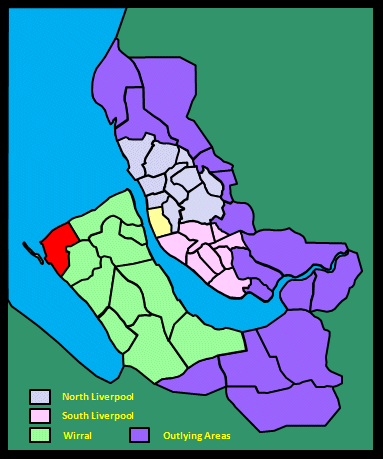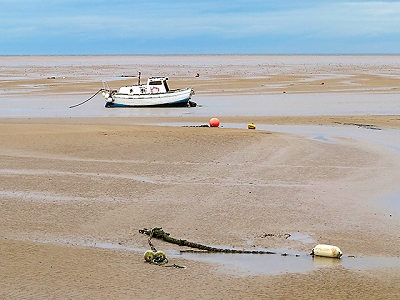 |
Dove
Point, Meols
Meols, whose name comes from the Old Norse for sandbanks
or sandhills, was a major seaport and trading post for
the Viking settlers in Wirral. The coastline at Meols at
this time reached significantly further out with a
promontory at Dove Point that has been washed away. Major
Viking archeological finds were made in the 19th century
that were only revealed at exceptionally low tides. Meols
was a major seaport and trading post for the Viking
settlers in Wirral. Norse expeditions had started at the
beginning of the 8th century, but they really took off
after the unification of Norway in 872, when many nobles
took issue with the King Harald I. A large number settled
peacefully in the newly founded Viking kingdom of Dublin
and some became Christianised by the native Irish.
However they were expelled from Ireland beginning in 902
by Caerbhall, leader of the Leinster Irish, and
continuing until 1014 with the Battle of Clontarf. Many
of these ex-Norwegians settled finally on the Wirral,
having being granted permission to do so by Edelfrida,
daughter of Alfred the Great. There were many Danish
Vikings in Wirral as well, as witnessed by placenames
ending in -by. The Danes originally settled in
East Anglia from 865 but soon moved north to Northumbria.
Analysis of placenames suggests a further migration to
Cumbria and south-west Scotland and from there to join
the Norwegians on the Isle of Man. It is thought that the
Wirral Danes arrived in quantity from there. The boundary
of their dominion probably tracked the south and east
edges of Tranmere, Storeton, Brimstage, Thornton Hough,
Raby (boundary village in Old Norse) and Little
Neston. The coastline at Meols at this time reached
significantly further out with a promontory at Dove Point
that has been washed away. There were major Viking
archeological finds in the 19th century far out and only
revealed at exceptionally low tides. My thanks to www.geograph.org.uk
for allowing me to use the photograph of Dove Point. |
 |
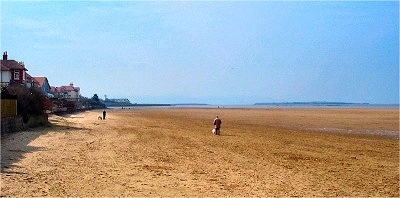 |
Hoylake
Shore
Modern Hoylake is the union of two ancient villages:
Little Meols and Hoose. Little Meols was the area near
the present Hoylake railway station and Hoose was the
present old village area around the Plasterer's Arms.
Great Meols was the area now known simply as Meols. The
name Hoylake is derived from the 'High Lake', a channel
that once extended several miles along the coast from
Hilbre to Dove Point at Meols. At low tide it was
protected by a wide sandbank, providing a safe anchorage
for ships that were too large to sail up the Dee to
Chester. In the 17th Century, Hoylake was one of the main
embarkation points for troops sailing to Ireland,
including (in 1690) King William III and his army of
10,000. To assist shipping, two lighthouses were built
around 1760, both rebuilt in the 1860s. By the 1830s, the
cutting of a new channel to Liverpool marked the end of
Hoylake's relevance for shipping and the focus shifted to
fishing. Gradually, the more affluent took an interest in
Hoylake, attracted by its fine beaches and opportunties
for the newly fashionable sea-bathing. The arrival of the
railway in 1886 caused a rapid expansion of the
population and the growth of the town both as a resort
and as a commuter base. Today, Hoylake is perhaps most
famous for the Royal Liverpool Golf Course, originally a
nine-hole course founded by local enthusiasts in 1869. |
 |
Great Meols in Lewis's
Topographical Dictionary of England (1848)
A part of it, which fronts the Irish Sea for upwards of
two miles, consists of a narrow slip of sandhills,
protected in some instances by embankments from the
inundations of the sea: as it approaches Hoose, the slip
widens, and becomes connected with that township. |
Hoose in Lewis's
Topographical Dictionary of England (1848)
This township, which comprises only 74 acres, of a sandy
soil, is not mentioned in the Domesday survey; which may
be attributed to its being so small, and lying between
Great and Little Meolse, of which it was probably then a
part. [...] The sea front of the three townships occupies
a line of upwards of five miles, reaching from the
western part of Wallasey to the village of West Kirby.
The inhabitants of Hoose are principally boatmen and
fishermen, who have frequently evinced the greatest
courage and alacrity in rescuing mariners from the
horrors of shipwreck; large banks of sand, extending for
miles on the northwest, being annually the scene of most
fatal disasters to shipping. |
Little Meols in Lewis's
Topographical Dictionary of England (1848)
The greater part was a waste, until Lord Stanley of
Alderley granted a building-lease for a term of eighty
years, which has led to the erection of several pleasing
villas. These, for summer residences and the convenience
of excellent sea-bathing, notwithstanding the apparent
want of attraction from their being seated amid sandhills
on the desolate extremity of a mere promontory, are in
great request, and a considerable increase may be
anticipated in their number. In this township and Hoose
is Hoylake, where his lordship's father erected, on the
margin of the sea, one of the most spacious hotels in the
county, now much frequented during the bathing season. A
little to the north is a smaller hotel. A commodious
church, also, has been erected by the lady of Mr.
Swainson, which affords great accommodation to the
inhabitants and the numerous visiters attracted hither,
who before had no place of worship nearer than the parish
church; it is dedicated to the Holy Trinity, and is a
neat edifice in the Norman style, from designs by Mr.
Picton, of Liverpool. |
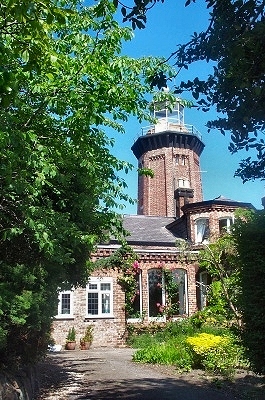 |
Hoylake
Lighthouse, Hoylake
Hoylake Upper Lighthouse was first established
here in 1764, when, together with the Lower
Lighthouse and the two Leasowe lighthouses (only one
extant), it was one of the four Leading Lights for
guiding shipping into the Mersey estuary. The lights were
used for alignment purposes and the Lower Lighthouse was
actually movable in order to adjust to the shifting sand
banks. Both lighthouses were demolished in 1865 and
rebuilt. The Upper Lighthouse remains on Valentia Road.
It is an octagonal brick building that was decommissioned
in 1886 and is now part of a private house incorporating
the former lighthouse keepers' quarters. The Lower
Lighthouse was a similar structure on the shore on what
is now North Parade, alongside the lifeboat house (now
the Lifeboat Museum) and the coastguard station. It
became disused as such in 1908 and was demolished in
1922. |
 |
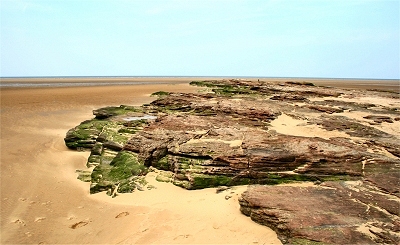 |
Red
Rocks, Hoylake
These isolated rocks off Hilbre Point (submerged at high
tide) form part of the Red Rocks Site of Special
Scientific Interest. Red Rocks themselves are an
important site for migrant birds, over 200 species having
been recorded here. |
 |
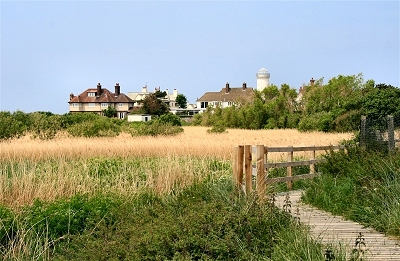 |
Boardwalk,
Hilbre Point, Hoylake |
 |
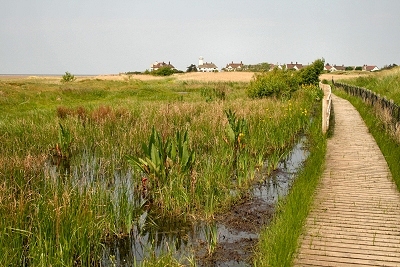 |
Red
Rocks Marsh
Red Rocks Marsh is part of the Site of Special Scientific
Interest. It is an area of sand dunes, dune slacks
(ponds), reedbeds and marsh, important for many species
of wintering birds. The open pools are the only area in
the Wirral that provide a habitat for the rare natterjack
toad. |
 |
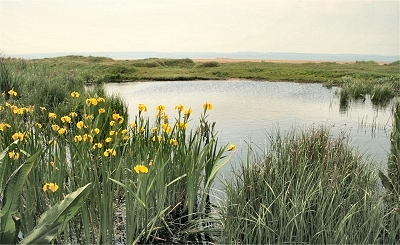 |
Pond
in Red Rocks Marsh |
 |
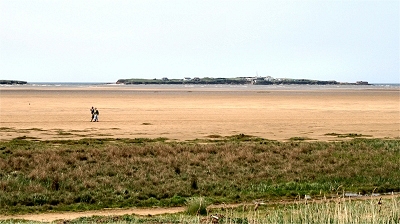 |
Hilbre
Island from Red Rocks Marsh |
 |
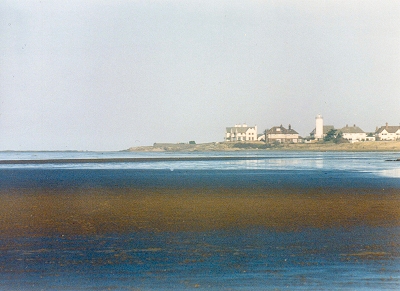 |
Hilbre
Point, Hoylake
This is the extreme north-west corner of the Wirral
mainland, seen across the West Kirby shore at low tide
with the Irish Sea beyond. |
 |
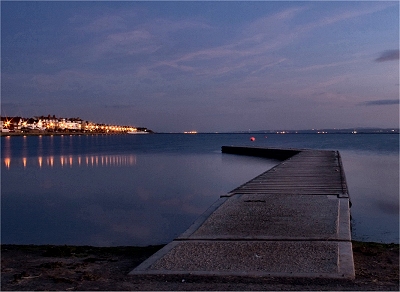 |
West
Kirby at Night
Thanks to Dave Steel for this photo. |
|
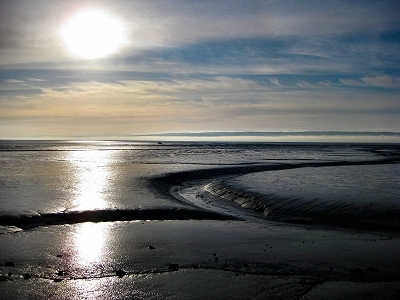 |
Low
Tide at West Kirby
Thanks to Paul Scales for this photo. |
 |
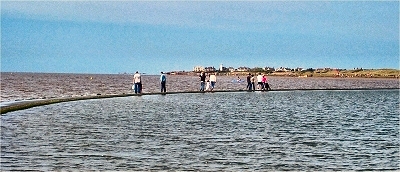 |
The
Marine Lake, West Kirby
At high tide on the sea wall of the marine lake you can
seem to be walking on water. |
 |
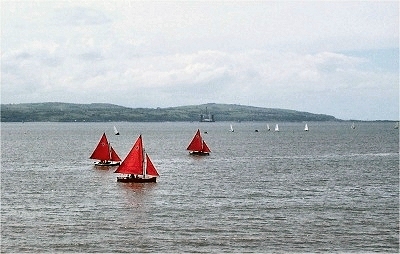 |
The
Dee Estuary at Cubbins Green, West Kirby |
 |
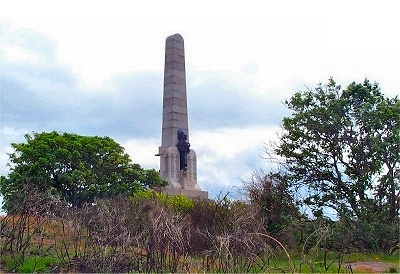 |
The
War Memorial, Grange Hill, West Kirby |
 |
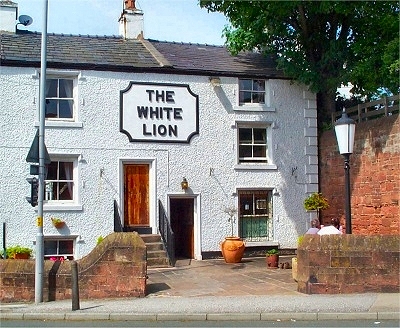 |
The
White Lion, West Kirby
This old pub on Grange Road has bags of character. Inside
is a maze of cosy small rooms, only partially knocked
through, with walls constructed of massive bare sandstone
blocks. Situated on the edge of Grange Hill, it almost
seems to grow out of the bedrock. |
 |
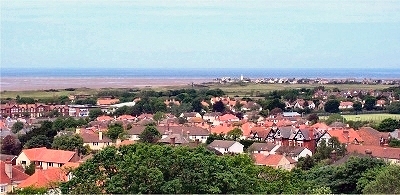 |
West
Kirby and Hilbre Point from Grange Hill |
 |
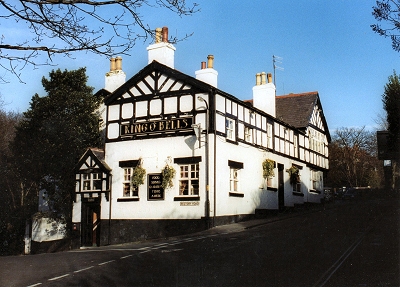 |
The
Ring O'Bells, West Kirby
The Ring O'Bells was rebuilt in 1810 on the site of an
older pub of the same name. The name presumably comes
from the nearby St. Bridget's Church that has its origins
in Norman times. The cellars are apparently cut into
sandstone and extend underneath the road, where the rock
has been shaped to hold barrels of ale with a drainage
channel below. The pub is in Village Road, an area of
West Kirby that seems untouched by the centuries. |
 |
 |
West
Kirby Old Village
West Kirby, in common with much of the Wirral, was
occupied by Christianised Vikings from Ireland. The other
Kirby was then Kirby in Walea to the east, now known as
Wallasey. The original settlement was around here in the
old village. For many centuries, West Kirby was a small
agricultural community, but the arrival of the railway in
1886 changed all that and by 1900 the population was
11000, many commuting into Liverpool to work. From about
this time, West Kirby also developed as a resort for
holidaymakers and day-trippers, the latter still very
much in evidence. |
|
West Kirby in Lewis's
Topographical Dictionary of England (1848)
It is bounded on the north by the Irish Sea, and on the
west by the estuary of the Dee; and from some rising
ground about a quarter of a mile from the shore,
extensive views are obtained of the Irish Sea, the river
Dee, and the Flintshire and Carnarvonshire hills. The
quality of the soil varies materially in different parts.
In the townships on the sea-shore it is very light and
sandy, and, being in a great measure sheltered by hills
from the easterly winds, is particularly suited for the
growth of early potatoes, for which the district has long
been celebrated. Some extensive commons are yet
unenclosed, and much even of the best land in the parish
affords scope for improvement. |
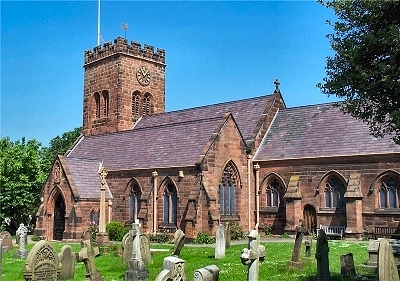 |
St.
Bridget's Church, West Kirby
Although much altered over the centuries, the oldest
identifiable parts of St. Bridget's church are parts of
the chancel, vestry, east bay and north aisle, dating
from around 1320. The present tower was built in 1493. A
major restoration (almost a rebuilding) was undertaken in
1869-70. A church had been founded on this site by the
Vikings in the 10 century. The name Kirby is Old
Norse for village of the church. St. Brigit of
Kildare (ca. 451 - 525) is one of Ireland's patron
saints. |
 |
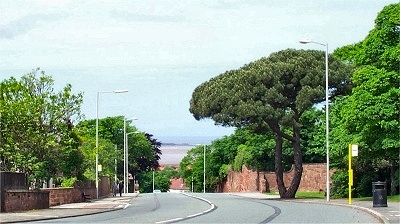 |
Grange
Road, West Kirby
This is the first view of West Kirby when driving in from
the south - a sudden enticing glimpse of the sea and
Hilbre Island. The fine tree on the right is an Umbrella
Pine, a native of southern Europe famous for its edible
pine nuts but rare at these latitudes. It was once
located in a private garden before the new road took
priority. |
 |
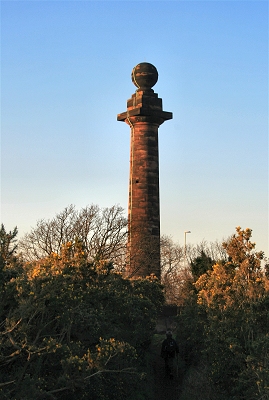 |
The
Beacon, Caldy Hill, West Kirby
The Beacon stands on the site of an old mill that was
used as a landmark by mariners navigating into the River
Mersey. It was destroyed in a storm in 1839 and the
present 60ft (18m) column was erected in 1841 by the
trustees of the Liverpool Docks by permission of the
landowner John Shaw Leigh, who also gave the stone for
its construction. |
 |
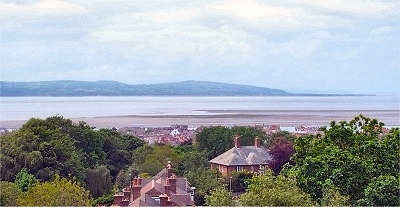 |
The
Dee Estuary from the Beacon, West Kirby |
 |
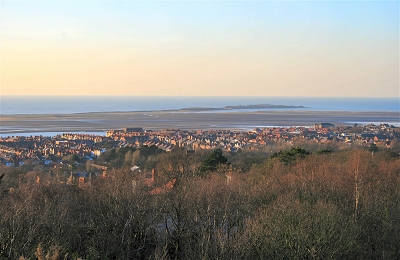 |
West
Kirby and Hilbre Island from Caldy Hill |
 |
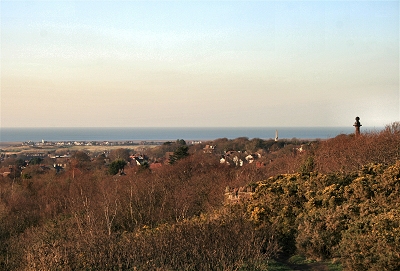 |
Grange
Hill from Caldy Hill |
 |
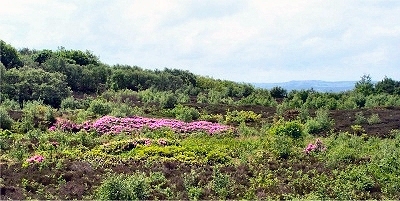 |
Caldy
Hill Heathland
Caldy Hill is a Site of Biological Importance as a
lowland heath habitat for, among others, common lizards,
grass snakes and adders. It is a lovely area for walks,
criss-crossed with trails where you can find peace and
quiet with fine views. |
 |
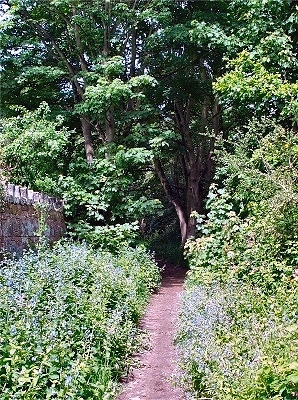 |
Fleck
Lane, Caldy
Fleck Lane is a picturesque path that runs dowm Caldy
Hill between old boundary walls. |
 |
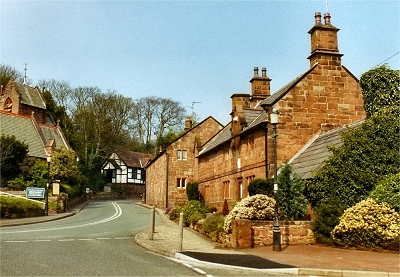 |
Caldy
Village
The village was bought and renovated by R.W. Barton, a
Manchester businessman, in 1832. There is real old world
charm here. The lovely old cottages, some in sandstone
and some in mock Tudor style, date from around 1700 and
were originally farm buildings. The surrounding
residential area is of a kind often referred to by estate
agents as 'much sought after', though I doubt there are
that many people with the wherewithal for the 7 figure
price tags. |
 |
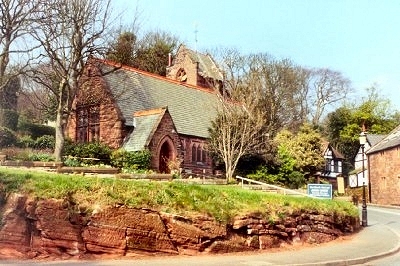 |
The
Church of the Resurrection and All Saints, Caldy
The church, originally a school, along with the manor
house behind it, was built in 1868 as part of R.W.
Barton's redevelopment of the village. It was in use as a
chapel from 1882 and, following extensive alteration, was
consecrated under its present name in 1907. |
 |
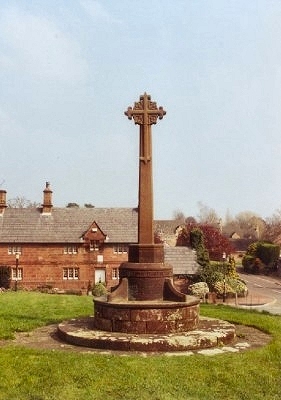 |
The
Village Cross, Caldy |
 |
